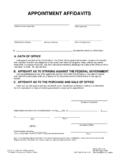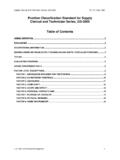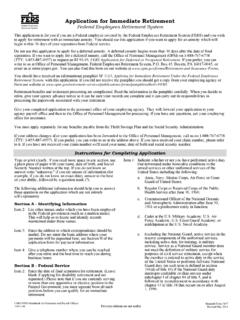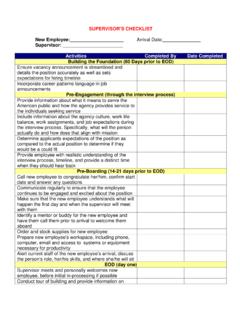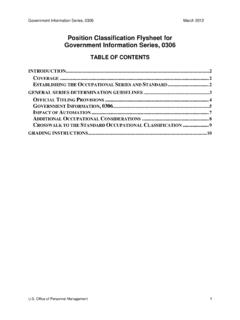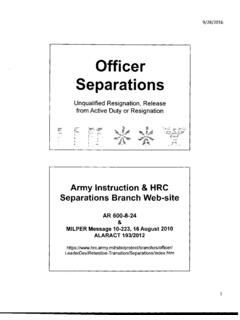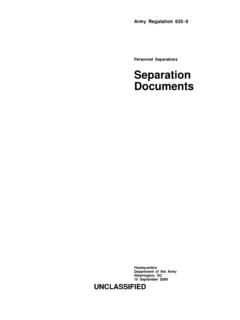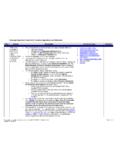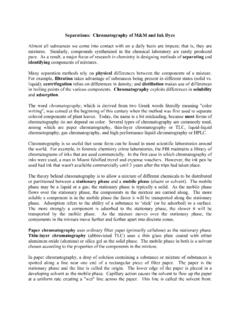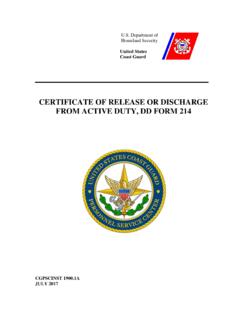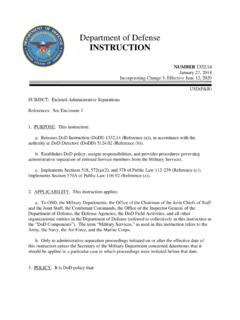Transcription of Chapter 31 - Separations by Other than Retirement
1 31-1 Chapter 31. Separations by Other than Retirement (Natures of Action 312, 317, 330, 350, 351, 352, 353, 355, 356, 357, 385, and 390) Contents 1. Coverage.. 31-3 2. Definitions.. 31-3 3. Selection of Legal Authority.. 31-4 4. Documenting Reason(s) for Separations .. 31-5 5. Effective Dates.. 31-6 6. Instructions.. 31-7 Job Aid Actions When an Employee Separates .. 31-9 Tables 31-A. Documenting Resignations .. 31-11 31-B. Documenting Separations Other than Resignations and Retirements .. 31-17 31-C. Codes for Required Remarks .. 31-27 31-D. Codes and Corresponding Remarks .. 31-37 Page 31-2 is blank. 31-3 Chapter 31. Separations by Other than Retirement 1. Coverage. a. Separations are actions that end employment with an agency. This Chapter covers Separations by Other than Retirement . Actions covered include: resignations; terminations; removals; Separations due to reduction in force; Separations to enter the uniformed services; and deaths.
2 It includes those involuntary Separations under which the employee may be eligible for discontinued service Retirement , or MRA+10 retirements when the employee chooses to postpone the MRA+10 annuity commencing date beyond 31 days after separation . (See Chapter 44 and 42, respectively, of HUThe CSRS and FERS HandbookUH.) b. This Chapter does not cover: retirements ( Chapter 30); movements from one part of an agency to another ( Chapter 14); changes in the human resource system serving the employee (not an official personnel action); or details to a State or local government, to an institution of higher learning, to another agency, or to an international organization ( Chapter 14). 2. Definitions. a. Appeal Rights An appeal right is an opportunity provided by law, Executive Order, regulation, or agency procedures to challenge a proposed action by presenting evidence and/or calling witnesses before an agency official who has the authority to modify or rescind the proposed action.
3 For purposes of this Chapter , the right to challenge an action through procedures designed to handle complaints of discrimination or violation of merit system principles is not an appeal right. b. Resignation a separation initiated by an employee. c. Resignation ILIA (in lieu of involuntary action) a separation initiated by the employee under circumstances that meet the definition of involuntary separation in Chapter 44 of HUThe CSRS and FERS HandbookUH. d. Removal a separation from Federal service initiated by the agency, the Office of Personnel Management or the Merit Systems Protection Board under parts 359, 432, 731, or 752 of title 5, Code of Federal Regulations; section 1201 of title 5, Code; or comparable agency statutes or regulations. (Note: This Chapter covers actions that remove an employee from the agency. Most removals from the Senior Executive Service under part 359 result in conversion to an appointment outside the Senior Executive Service.)
4 These conversions are covered in Chapters 9-11.) e. separation -Appt In (name of entity)-a separation when an employee leaves a Federal agency to accept employment with a non-Federal Government entity that takes over his or her Federal functions AND the employee will continue to receive Federal benefits. f. separation -US (uniformed services) a separation action initiated by the agency when the employee enters on duty with the uniformed services. (Note: This action is not appropriate when an employee fails to return, and did not provide written notice of intent not to return. In that case, he or she is subject to the policy and disciplinary 31-4 THE GUIDE TO PROCESSING PERSONNEL ACTIONS action the agency would normally apply for a similar absence without approval.) g. separation -RIF a separation from the agency under parts 351 or 359, title 5, Code of Federal Regulations, or as a consequence of reduction in force. h. Termination-Appt In (agency) a separation action initiated by either the employee or the agency when the employee (or a group of employees) moves from one agency to another agency.
5 I. Termination during Prob/Trial Period an agency-initiated separation of an employee who is serving an initial appointment probation or a trial period required by civil service or agency regulations. j. Termination-Exp of Appt a separation action initiated by the agency to end employment on the not-to-exceed date of a temporary appointment. k. Termination-Sponsor Relocating an action to document the separation of a Department of Defense employee who submits a resignation to accompany a military or civilian sponsor to a new duty station. 3. Selection of Legal Authority. a. Meaning of equivalent to CS Regs. For some actions covered by this Chapter , the legal authority will depend on whether the action is being taken under civil service laws and regulations, under agency procedures that are equivalent to those required under civil service laws and regulations, or under Other procedures. To select the legal authority, you must know what procedures were used.
6 If you are not sure, ask the person who approved the action. You cannot select the correct authority without knowing the procedures used to effect the action. b. Agency-Unique Authorities. If the action is being taken under an authority that is unique to your department or agency, cite that authority instead of the authority and code shown in this Chapter . The Office of Personnel Management must have issued an authority code before an agency-unique authority can be used instead of the authorities shown in this Chapter . c. Actions for Which the Agency Must Select the Authority. For some actions you will be given a legal authority code and told to cite the appropriate authority. (1) If a specific law, Executive Order, regulation, or agency directive was the basis for the action, cite it in the legal authority block on the Standard Form 52/50, along with the legal authority code shown in the table. (2) When the employee is serving on a temporary appointment and no Other law, Executive Order, regulation, or agency directive applies to the action, cite the appointment authority in the legal authority block on the Standard Form 52/50, along with the legal authority code shown in the table.
7 (3) For situations not described in paragraphs (1) and (2), cite 5 302 in the legal authority block on the Standard Form 52/50, along with the legal authority code shown in the table. 5 302 is the general authority for an agency head to delegate authority to take actions necessary to carry out personnel actions. Cite it only in those rare instances when no Other authority is appropriate for the action. 31-5 4. Documenting Reason(s) for Separations a. Need for Remarks. Most of the actions in this Chapter require remarks that document the reasons for the action. These remarks are used to determine future employment eligibility and eligibility for various benefits, including unemployment compensation. When a former employee applies for unemployment compensation, the State employment security agency will use the nature of action and the remarks to adjudicate the claim. Inadequate or incomplete information about the separation may result in delays or errors in processing such claims.
8 B. Employee's Reason for Resignation. (1) Each person who resigns should be asked to do so in writing. Part E of the Standard Form 52 is one option for submitting a written resignation. When the employee resigns orally, try to obtain written confirmation. If this is not possible, ask the person who received the oral resignation to document it in a memorandum for the record. (2) In the remarks section of the Standard Form 50, quote in full the employee's reason for resigning. If the employee s reason is so lengthy that it will not fit in the space available, summarize it. The entire reason will remain a matter of record because the resignation is a long term Official Personnel Folder document. c. Agency Comments Regarding Employee's Reason for Resignation Agency Finding. (1) Employees without appeal rights. When the employee is serving an initial appointment probation or a trial period required by civil service or agency regulations, or when employee is serving under an appointment that does not afford appeal rights, NO agency comments or findings regarding the employee's resignation may be placed on the Standard Form 52, Standard Form 50, in the employee's Official Personnel Folder, or in the Employee Performance Folder.
9 (2) Employees with appeal rights. Agency findings should be documented on the resignation Standard Form 50 only when the employee has appeal rights and has been notified in writing of an agency action BEFORE the resignation was submitted. Agency findings should be documented if the employee was notified of: - a proposed or pending disciplinary or adverse action; - a proposed or pending position change due to failure to complete a supervisory/managerial probationary period successfully; - action to withhold a within-grade increase; or - proposed removal from the Senior Executive Service. Unless the employee was notified in writing BEFORE submitting the resignation, do NOT record any adverse agency findings on the Standard Form 52, Standard Form 50, in the Official Personnel Folder or the Employee Performance Folder. d. Agency-Initiated Separations . (1) Employees without appeal rights. When an employee who is serving on an appointment that does not afford appeal rights is separated for conduct and/or performance reasons, NO agency reasons for or comments regarding the action may be placed on the Standard Form 52, the 31-6 THE GUIDE TO PROCESSING PERSONNEL ACTIONS Standard Form 50, in the Official Personnel Folder or Employee Performance Folder.
10 (2) Employees with appeal rights. When an employee serving on an appointment that does afford appeal rights is separated by the agency, the agency must summarize the reason(s) for the action in the Standard Form 50 remarks. The reason(s) must be consistent with any written reason(s) previously given the employee as the basis for his or her separation . e. Unemployment Compensation Claims. An agency may have factual information that would impact on a former employee s unemployment compensation claim but is not documented on the separation Standard Form 50. In these cases, the agency may retain that information in a subject file that is separate and apart from the employee's personal records or any Other records that are filed by and retrieved by employee name or employee identifier (such as an employee number, a payroll number, or Social Security Number). These files are retained for two years from the effective date of the separation .

